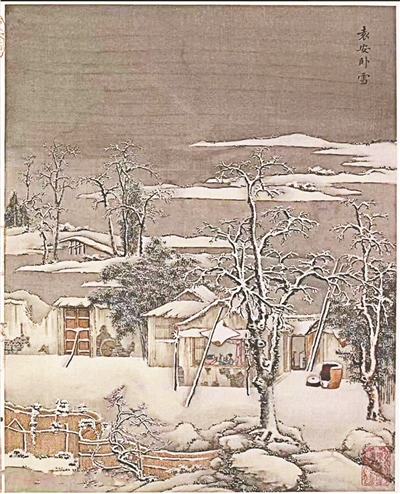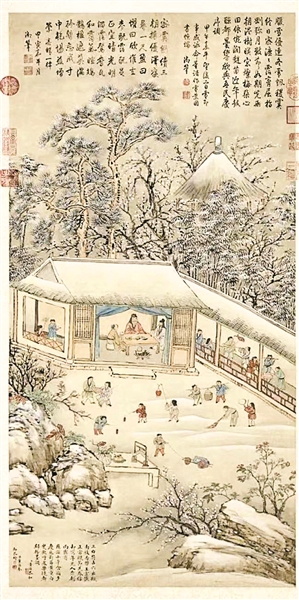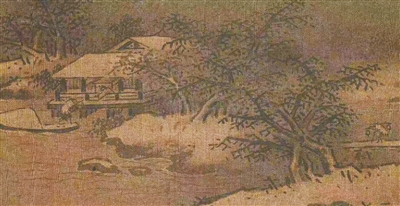
Yuan an lies in snow

The Snow Lion Map (partial) Yu Ming

"Painting Emperor Gaozong’s Imperial Pen after Jiawu Snow" Qing Dong Gao

Fish Selling in Snow River (Partial) Li Dong in Southern Song Dynasty
Every winter, we will see many different forms of snow, especially this year’s Winter Olympics, and various competitive competitions have opened up our "new world of ice and snow". As a modern person, the process of enjoying the snow is naturally to take photos, shoot videos and send friends, so what will the ancients with big brains do in snowy days? We might as well travel through the circle of friends into ancient paintings and books, and enjoy the snow that has fallen for thousands of years with the ancients.
"Ice mound" and "snow melting" … … Not enough, properly pile up a zoo.
As the mascots of the Winter Olympics, the ice pier and the snow rongrong burst into red overnight, becoming a veritable top stream of the Beijing Winter Olympics, especially the ice pier, which can be described as "one pier is hard to find" whether online or offline. Coincidentally, at this time, there was heavy snow in many cities in China, so netizens who couldn’t buy ice piers built ice piers with snow. Many netizens shouted "creative" in the comment area.
In fact, it is not an innovation for modern people to use snow mounds and ice mounds. On the contrary, it is a trend of "retro", because in ancient snowy days, ancient people will also play this kind of game full of childlike interest. But instead of building a snowman, they are mainly animals, such as lions. According to "Dream of Tokyo", "In a rich family, if it meets snow, it will have a feast, make snow lions and install snow lanterns to celebrate the old days." Yes, you are right. The ancients played with snow in such a grandiose way. Simple snowmen don’t pile up. If you want to pile up, pile up a snow lion and come out of town.
Not only rich people like to pile snow lions, but even the palace in the Song Dynasty is full of interest in snow lions. In the Southern Song Dynasty, Zhou Mi recorded in detail the basic process of enjoying snow lions in the palace at that time: "In the back garden, large and small snow lions were brought in, decorated with golden bells, and made snowflakes, snow lanterns, snow-capped mountains and the like." In the imperial palace of the Song Dynasty, snow lions, large and small, should not only be piled up, but also be adorned with jewelry, such as hanging golden bells around their necks and wearing colorful silk threads. In order to meet the occasion, in addition to snow lions, the ancients also piled snow mountains, snowflakes, snow lanterns and so on. Among them, the "snow lamp" is reminiscent of the "snow melting" of the Beijing Winter Olympics. It is a kind of lamp made of snow, which has the same effect as the image of a red lantern with snow hanging on it, and looks like it is moving and moving.
But then again, why did the ancients love lions so much? Is the snow lion piled by the ancients the same species as the lion that we modern people see in the zoo?
As early as the Han Dynasty, in order to establish diplomatic relations with the Great Han Dynasty, the interest country paid tribute to the lion and Fu Ba, and called them "Swiss beasts". Gradually, the image of the lion has also penetrated into the daily folk life of the ancients. The most typical one is that a large number of "stone lions" appeared in ancient times, because the ancients thought that stone lions were spiritual and could guard all directions. Yu Shinan, a scholar in the Tang Dynasty, wrote a poem "Ode to the Lion", in which he mentioned that the lion was a sacred animal. Later, Li Shizhen, a medical scientist, called the lion "the leader of many animals". It can be seen that the lion has always been a symbol of good luck, and it is also a manifestation of identity in the palace. As for the snow lions piled up by the ancients in snowy days, they are generally like stone lions: first, stone lions are more common, and the ancients don’t have to open too many brain holes; Second, the image of the stone lion is relatively stable, and it is not easy to collapse after stacking!
After the Qing Dynasty, the ancients no longer focused on piling snow lions, but began to pile elephants and horses. In the Qing Dynasty, wu zhen Machinery recorded in Volume 14 of the Collection of Keeping Ji Zhai: "Every time it snows in winter, it piles up into lions and elephants in hall of mental cultivation’s court, and Chen Yong is often invited to sing. Ganlong Renshen, Yiyou, combined with snow lion and snow elephant. Jiaqing Wuyin, another pile of lying horses, is divided into east and west, and there are poems linked with the Imperial Palace Hanlin. " When the snow lion, the snow elephant and the snow horse are piled up, the emperor and the Hanlin scholar in the palace will also use this as the theme to recite poems and compose poems. In the Ci of Bianjing Palace written by Yan Jizhou during Guangxu period, there are poems describing the snow appreciation and entertainment in the palace, such as: "Ruixue is colorful in the sky, and lions are piled up in front of the stage."
It can be seen that in snowy days, the ancients also loved mascots to the extreme.
Snowy days are still inseparable from the word "eat and drink", even Bunny Bunny.
It’s enjoyable to use the snowmobile mascot, but it’s a little cold after all, and when it’s cold, you will be hungry, so the ancients’ favorite thing after playing with snow is to have dinner. On a snowy day, the most classic is the a suggestion to my friend liu written by Bai Juyi in the Tang Dynasty: "there’s a gleam of green in an old bottle, there’s a stir of red in the quiet stove. There’s a feeling of snow in the dusk outside, what about a cup of wine inside?? " On a snowy evening, the newly brewed rice wine at home has not been filtered, and there is a layer of green bubbles on the wine surface, and the small stove made of red mud is ready, just waiting for a good friend to drink!
Some people have an appointment for dinner, and naturally some people will come to eat rice. The ancients who paid attention to etiquette can’t come to eat rice empty-handed, right? Under normal circumstances, the ancients would bring some good wine or some snacks to eat, but Lin Hong’s cookbook "Shan Jia Qing Gong" in the Southern Song Dynasty recorded one thing, and the gift he brought to visit was really special: "When you visit Wuyishan Six Songs, you will get a rabbit in snowy days, and no one can control it. Shi Yun: Only a thin batch is used in the mountains, and the wine, sauce and pepper are abundant. Use the air furnace to cook Azakami, use less water than half a cup, and after the soup rings, use chopsticks for each, so that the soup can be cooked and cooked, so that it can be served with juice as appropriate. "
Lin Hong visited his friends on a snowy day, but he actually caught a rabbit on the way, so this rabbit was the gift of his visit. But there was no cook in the mountains, so Lin Hong’s friend thought of a way. He said to Lin Hong, "Everything can go into hot pot! I’ll prepare some dip, and today we’ll rinse the rabbit hot pot! " Sure enough, in the eyes of foodies, rabbits are not pets, but food.
In addition to washing meat, the ancients especially liked to eat fish in snowy days. In the Palace Museum and the Metropolitan Museum of Art in New York, there is a picture of a round fan, the former is called "Fish Selling in Snow River" and the latter is called "Fish Buying in Snow Bridge". In the snow landscape map, buying and selling live fish, which seems to be full of fireworks, brings interest to the picture. Although many scholars think it is used to reflect the ideal spiritual world of literati and fishermen, it also confirms the fact that the ancients like to eat live fish in snowy days. Not only the ancients in the Central Plains loved to eat live fish in snowy days, but also the nomadic people in the north. They would dig ice holes in the frozen rivers and lakes in winter to catch big fish. A kind of fish hook used by the Khitan people to hook fish was unearthed in Yemaotai Liao Tomb, Faku, Liaoning Province. It has a sharp hook tip, a long hook body and a wooden handle, which is an artifact used to "hook fish with ice".
After eating meat and drinking wine, the ancients also drank some tea to scrape oil in snowy days. However, how can the ancients who have always had a big brain hole only cook tea so honestly? Yes, they’re up to something again. In the eyes of the ancients, normal mountain springs could no longer satisfy their pursuit of snow and elegance, so they targeted snow.
In the Ming Dynasty, Gao Lian once said in "Sweeping Snow and brew tea Playing with Paintings": "Tea cooked with snow tastes clearer, and it is also a river for half a day. Free from dirt, it’s enough for you to sip it. " It seems that the ancients not only used snow brew tea in snowy days, but also took snow from plum blossoms, orchids and pines. It feels that as long as they drink this cup of snow-cooked tea, they can have the cleanliness of snow, the pride of plum blossoms, the elegance of orchids and the integrity of pines. This is clearly our modern popular "concept tea"!
It is easy to get mad in snowy days. Zhang Dai collected wonderful jokes about snowy days.
After playing with snow, eating rice and drinking tea, it is naturally necessary to "pretend". We modern people often get some gimmicks to make a circle of friends in the snowy days. Some people practice yoga in the snowy days, some people wear Hanfu to the Forbidden City, and some people lie in the snowy days and imitate idol films to take pictures … … The "artificial" in the snowy days of the ancients is naturally very special and can be called performance art.
For example, in the Song Dynasty, there was a man named Wang Jiang who was wandering around Chen Zhou (now Huaiyang, Henan). Although he was a tramp, there were many fans at that time, and scholars like Su Dongpo and Su Zhe were his loyal fans. In addition to his bohemian love of freedom, this Wang Jiang has a special function, that is, in snowy days, he will bury himself with snow, and then melt it with a hot air. After the snow melted, Wang Jiang was fine and continued to wander while drinking. It is rumored that people who saw this scene at that time were greatly shocked.
Perhaps this is not the most wonderful thing in a snowy day. In the snowy day, Zhang Dai, a scholar in the late Ming Dynasty, not only went to the pavilion in the middle of the lake to see the snow by himself, but also wrote a small composition. He also did a great thing, that is, in the first volume of the book "Sailing at Night", he opened a column called "Astronomy Department Snow Frost" to collect wonderful jokes about snowy days. Among them, we are familiar with "catkins due to the wind", "Xun Mei through the snow", "Reading in the snow" and "biting snow and swallowing blankets", which are quite normal. The rest of the jokes can only shock us modern people.
For example, the joke "I want to go to the immortals" is said to be the yue people in Wang Mian. When it is snowy, they are not afraid of the cold and go barefoot to climb the furnace peak. After looking around, they shouted: "Heaven and earth are all made of white jade, which makes people feel clear and clear, so they want to go to the immortals!" Like Wang Mian, there is also a "fairy middleman" who likes to cultivate immortals. It is said in the article that Wang Gong of Jin once walked in the snow wearing a coat with crane hair. When Meng Xu saw it, he made a commercial compliment to him: "Oh! You are really a fairy! "
There is also a road flyover named Tiejiao, who is neither afraid of cold nor diarrhea. On snowy days, he loves to walk barefoot in the snow. When he is happy, he will recite "South China Autumn Water" loudly, then pick some plum blossoms and put them in his mouth to chew. When he feels a little dry, he will get some snow to swallow together. In this regard, he explained: "I want to soak this cold fragrance into my heart!" In this way, I am as fragrant as plum blossoms and as clean as snow! "
We don’t know whether these action art became immortals or not, but one action art got an offer on a snowy day. The name of this joke is very poetic, called "Lying Snow", and the protagonist is Yuan An, a famous minister in the Eastern Han Dynasty.
It is said that it snowed heavily in Luoyang one year, and everyone else went out to beg for food, except for the snow in front of Yuan ‘an. When Luoyang made a door-to-door inspection, he thought that Yuan An had died of cold and hunger, so he asked people to sweep away the snow in front of his door and then go into the house to have a look. After entering the door, Luoyang Ling and his entourage found Yuan An lying upright as if he were not dead, so he asked Yuan An, "Why don’t you go out?" Yuan An replied, "In this snowy day, everyone is hungry. We shouldn’t disturb others. I’ll lie down for a while … …” As soon as this is said, the pattern is there: it is not easy for people to keep moral integrity when they are hungry and cold! Luoyang made Yuan An a virtuous man, so he named him filial piety.
Since then, Yuan An’s story of sleeping in snow has actually become a Millennium super IP (intellectual property, which is extended to be a general term for famous cultural creation). Not only do poems like to use this story, but scholars also like to add this element to their snow landscape paintings. Perhaps Yuan An himself didn’t think that a heavy snow actually changed his life.
After brushing the circle of friends of the ancients in the snowy days, I must give the ancients a compliment. They are really good at playing! However, for all kinds of "playing" of the ancients, we modern people should remain sober and rational, only taste the ancient meaning, and can’t blindly imitate it. After all, we don’t have super energy like the ice pier!
Photo courtesy/Jinling Xiaodai